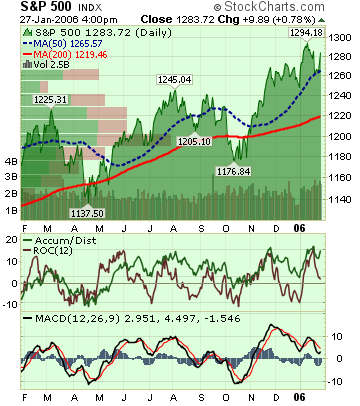
Click here for the Weekly Wrap by Briefing.com.
BOTTOM LINE: Overall, last week's market performance was very positive as US stocks posted meaningful gains even as worries over Iran’s nuclear program remained, oil stayed elevated, economic data was mixed, earnings were about at expectations and long-term rates increased. The advance/decline line rose, most sectors gained and volume was above average on the week. Measures of investor anxiety were mostly lower. However, the AAII % Bulls plunged to 30.77%, which is approaching depressed levels. This is a big positive for stocks. The average 30-year mortgage rate rose slightly to 6.12% which is only 91 basis points above all-time lows set in June 2003. The benchmark 10-year T-note yield increased 16 basis points on the week as fears over the previous Friday’s stock sell-off dissipated, new home sales bounced, the labor market strengthened further and signs of increased corporate spending were evident.
Unleaded Gasoline futures fell even as oil remained elevated on Iran fears and are now 40% below September highs even as refinery utilization remains below normal as a result of the hurricanes. Natural gas inventories fell slightly more than expected this week. However, supplies are now 22.0% above the 5-year average, approaching an all-time record high for this time of year, even as over 18% of daily Gulf of Mexico production remains shut-in. Natural gas prices have plunged around 46% in 6 weeks. Gold was about unchanged on the week as geopolitical concerns were offset by a rising US dollar.
I still believe prices for many commodities are being driven by fear and record capital inflows into commodity funds, rather than fundamentals. I continue to expect global energy demand destruction, decelerating economic growth and a significant increase in supplies into 2006 to push oil prices substantially lower from current levels. Elevated prices related to Iran only make this outcome more likely. Any temporary spike in energy price due to an attack on Iran or Iranian halt in oil production would likely be less severe and more temporary than most expect as speculators are already factoring in a substantial OPEC production disruption. This scenario would also likely lead to a Fed rate cut.
Small-caps outperformed again as the Russell 2000 made another all-time high on Thursday and is already up 9% for the year. In my opinion, US small-caps now offer similar return potential to that of most emerging international markets with much less risk. S&P 500 earnings growth for the fourth quarter is still on pace to rise 13% year-over-year, almost double the long-term average. This would be the 15th consecutive quarter of double-digit profit growth, the best streak since record-keeping began in 1936. Moreover, companies have sufficiently lowered the bar as to allow for better-than-expected 1Q results. The ECRI Weekly Leading Index made another cycle high and is forecasting continued healthy US economic activity. While volatility will likely increase going forward, I still expect the S&P 500 to return 15% this year, notwithstanding any temporary weakness related to issues with Iran. High single-digit earnings growth, average economic growth of around 3%, an end to Fed rate hikes, low long-term interest rates, lower energy prices, a healthy labor market, a more sustainable housing market, p/e multiple expansion, a stable US dollar, decelerating inflation, increased corporate spending, rising demand for US assets and a lifting of irrational pessimism should provide the catalysts for strong gains this year.
*5-day % Change
No comments:
Post a Comment